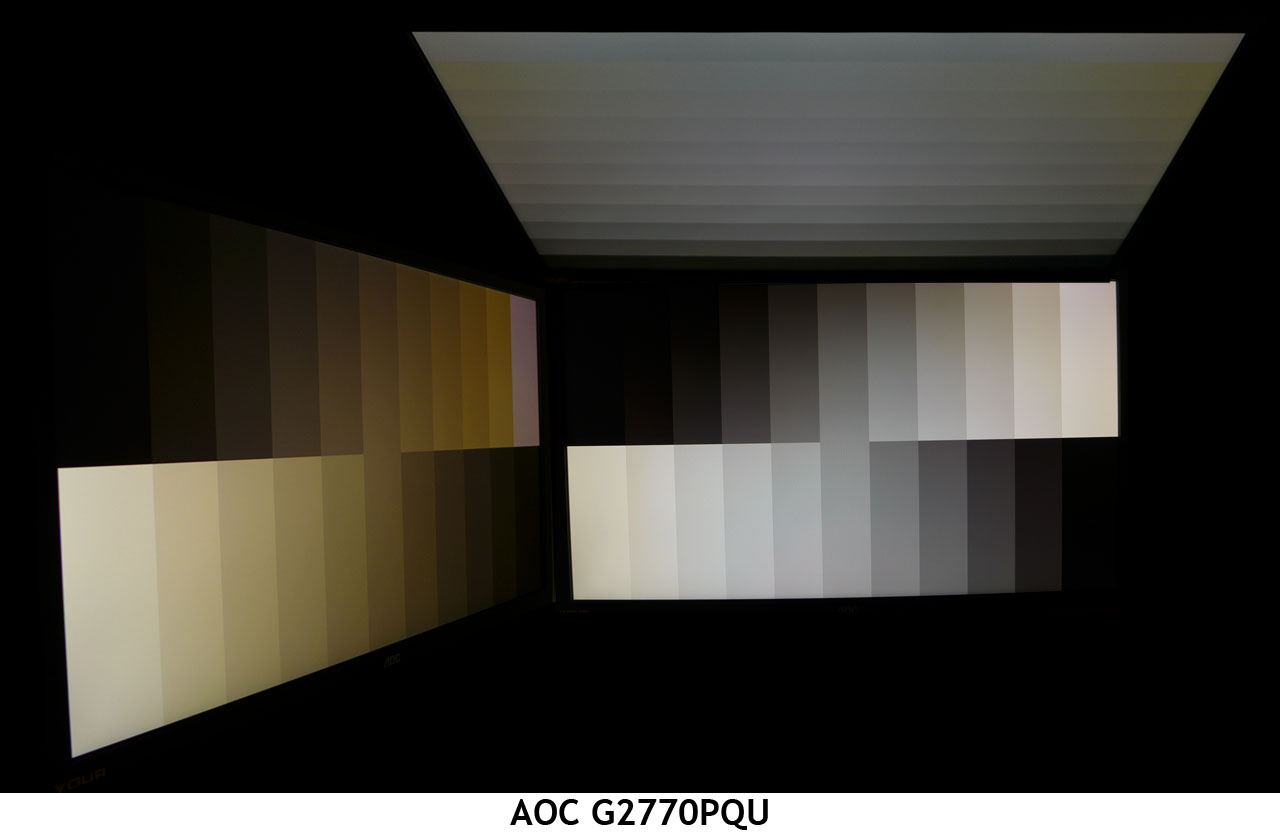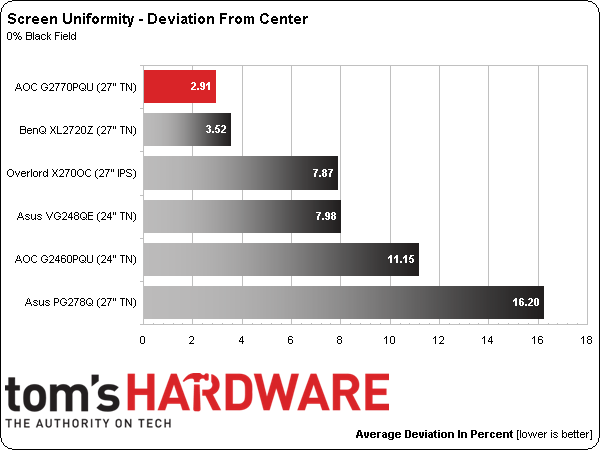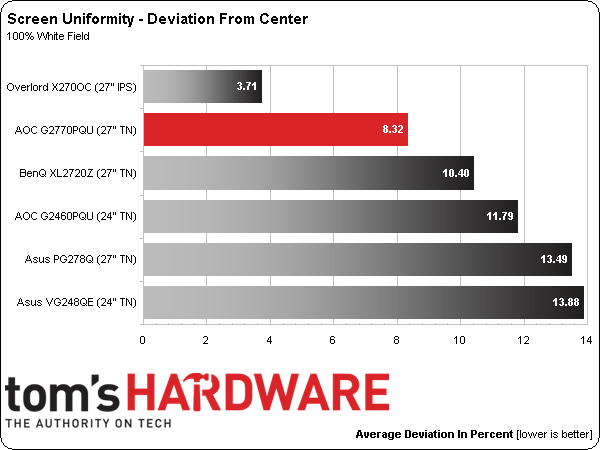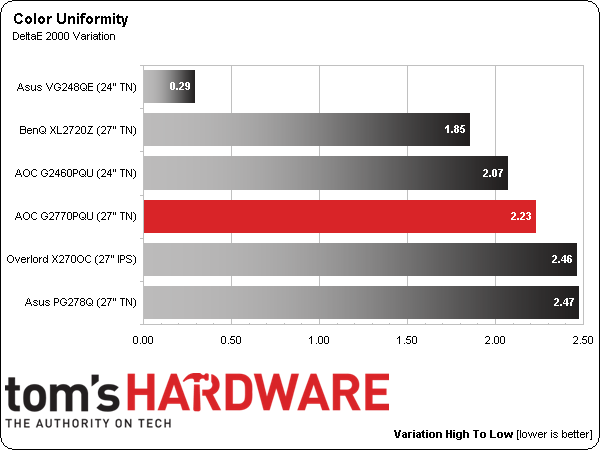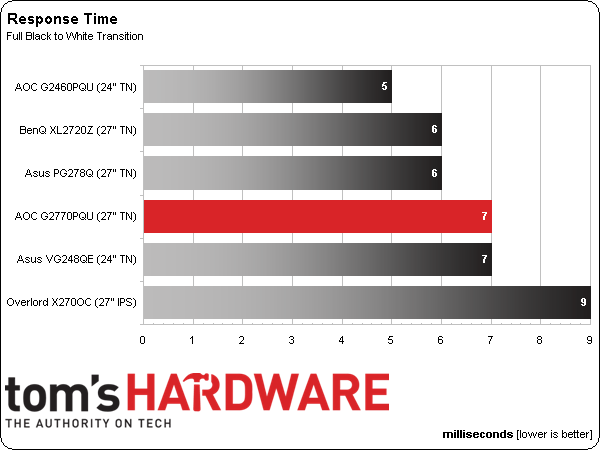AOC G2770PQU 27-Inch 144Hz Gaming Monitor Review
Today we’re looking at AOC’s other 144Hz gaming display, the G2770PQU. It delivers a 27” image at 1920x1080 resolution through a TN panel. With speedy G-Sync-capable monitors starting to emerge, is the tech still a relevant choice? We find out today.
Why you can trust Tom's Hardware
Results: Viewing Angles, Uniformity, Pixel Response, Input Lag
To learn how we measure screen uniformity, please click here.
While many users dismiss TN panel technology, its only real flaw is poor off-axis image quality. The G2770PQU looks like every other TN-based screen we’ve photographed. From the side, we see a significant red shift, light falloff, and crushed shadow detail. From above, there is almost no difference between the brightest and darkest steps. But as long as you view the screen head-on from two or three feet away, you probably won’t be able to tell it apart from an IPS display.
Screen Uniformity: Luminance
As we recorded the values for the black field pattern, we could tell we had a winner on our hands. The G2770PQU sample AOC sent us posts the best result out of all the monitors we’ve tested in this particular metric. It even beats the pro screens that include uniformity compensation.
Here’s the white field measurement:
The white field result is comfortably under 10 percent, which makes any aberrations invisible to the naked eye. The only measurable hotspot is at the center of the screen. The G2770PQU is obviously well-made with excellent quality control.
Screen Uniformity: Color
The color uniformity result is higher than average, but still well under three Delta E, where errors become visible. The main flaw, according to our meter, is in the upper-left portion of the screen.
Pixel Response And Input Lag
Please click here to read up on our pixel response and input lag testing procedures.
Get Tom's Hardware's best news and in-depth reviews, straight to your inbox.
We had to do things a little differently for this review because our pattern generator only goes up to 60Hz. So, we filmed a mouse movement that triggers the field pattern’s appearance. Since this is less precise than using the generator, we averaged five measurements. The tests were run at the G2770PQU’s maximum refresh rate of 144Hz.
The seven-millisecond result is right up there with the other 144Hz TN-based screens we tested. Overlord’s IPS display is only a tiny bit behind at nine milliseconds, which clearly shows the effect of refresh rate on screen draw time; faster refresh equals faster response.
Here are the lag results:
We were surprised that the G2770PQU couldn’t quite keep up with its stable-mate, the G2460PQU. Overall lag is much lower than any 60Hz display. But among our high-refresh screens, it’s the slowest.
Like the G2460PQU, AOC doesn't include any sort of blur reduction feature. After running through several of the Blur Busters tests, I can say that it is not sorely missed. When the refresh rate is maxed at 144Hz, motion is quite smooth and resolution in the most detailed images stays solid at fairly high motion rates. Would backlight strobing make it better? Yes, but only a little.
Remember that the downside to backlight strobing is a corresponding reduction in light output. This was an issue with the BenQ XL2720Z because its brightness maxes at about 300 cd/m2. After factoring in the 58-percent drop with Blur Reduction on full, you’re left with only 150 cd/m2, meaning you need a very dark room to see full detail in gaming titles.
Current page: Results: Viewing Angles, Uniformity, Pixel Response, Input Lag
Prev Page Results: Color Gamut Accuracy Next Page Speedy But Not The Speediest
Christian Eberle is a Contributing Editor for Tom's Hardware US. He's a veteran reviewer of A/V equipment, specializing in monitors. Christian began his obsession with tech when he built his first PC in 1991, a 286 running DOS 3.0 at a blazing 12MHz. In 2006, he undertook training from the Imaging Science Foundation in video calibration and testing and thus started a passion for precise imaging that persists to this day. He is also a professional musician with a degree from the New England Conservatory as a classical bassoonist which he used to good effect as a performer with the West Point Army Band from 1987 to 2013. He enjoys watching movies and listening to high-end audio in his custom-built home theater and can be seen riding trails near his home on a race-ready ICE VTX recumbent trike. Christian enjoys the endless summer in Florida where he lives with his wife and Chihuahua and plays with orchestras around the state.
-
eklipz330 "At 144Hz, motion is very smooth with no obvious ghosting or artifacting. While capabilities like LightBoost are helpful at 60Hz, we’re not sure they're really needed at the higher rates."Reply
I completely agree. I use a benq xl2411z, and i can understand turning on the blur reduction feature at 60hz. But at 100hz and up, i just don't see the reason why. the blur reduction actually detracts from the overall experience, increases ghosting and crosstalk in particular areas of the screen. Even with modded drivers, it still doesn't seem like the best course of action.
but light reduction at around 72hz is awesome. the only issue is the flickering, but man is the picture crisp -
NeatOman What do we want!?..Reply
- 2560x1440 144Hz ! !
When do we want it!?
- NOW ! !
From what i heard when you get close to 120Hz or above you almost can't see the tearing from no-sync at all vs G-Sync, but if it has it for little to now extra charge (like im hoping will happen with free-sync) then ok.. lol -
Bowmaster 2560x1440 144hz, <1ms response, OLED, under $500. Maybe someday... right now to do something like that would take a few more 0's on the price tag sadly, but that would look sooooo pretty at 27-30 inches. Fun to dream!Reply -
Bowmaster 2560x1440 144hz, <1ms response, OLED, under $500. Maybe someday... right now to do something like that would take a few more 0's on the price tag sadly, but that would look sooooo pretty at 27-30 inches. Fun to dream!Reply -
huilun02 All I ask for is a 60Hz 1080p IPS with Gsync/Freesync. Screen tearing elimination while still practical and economical. Low entry price for faster adoption by the masses.Reply
But no, manufacturers insist on making it exclusive to the most high end/expensive models. They want to milk the most out of this tech by keeping it elusive.
"With speedy G-Sync-capable monitors starting to emerge, is the tech still a relevant choice?" What a stupid question to ask. Just about every monitor that comes with Gsync ARE 144Hz TN panels. Where its benefit is the least noticeable... -
soldier44 Been gaming at 2560 x 1600 for over 4 years now and have moved to a Asus 32 inch 4K display with 2 GTX 780 Classifieds running it. Smooth as silk. 1080p is so 2008.Reply -
thequn i would be in if it was not a tn pan. unless they changed tech when I was not looking but its 6 bit color and not 8Reply
